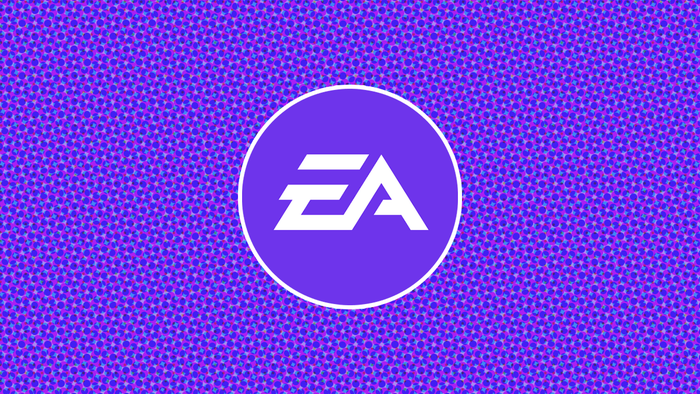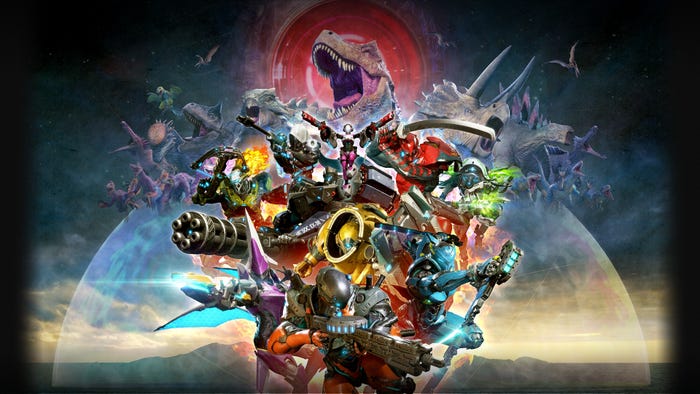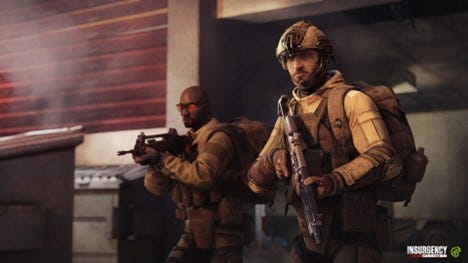
Featured Blog | This community-written post highlights the best of what the game industry has to offer. Read more like it on the Game Developer Blogs.
Flat Kingdom post-mortem. 30 months of learning and shaping our first indie game.
Redesigning the main character of a game after launch is something very rarely seen in games, especially after 30 months of development. In this article we analyse the story and reasons behind this and other steps we took in Flat Kingdom.

Links for this article's [Spanish version] and [Portuguese version].
The important part of this story began last April, a month after releasing our game, Flat Kingdom, on Steam. After 27 months of hard work, the launch did not yield the results we had expected. It was the first title for our publisher, Games Starter, who had been incubating and funding us over the last 13 months, and without whom this project would have been shelved. Although we launched strong, sales ended up falling off after only a few days, which made us seriously start analyzing what the reasons for this could have been. After the effort it took to pull off, we were left with a strong feeling of tension and guilt, needed solutions, and to act quickly before the game completely lost all novelty. We saw that we had failed to give full importance to launching the game in the best possible condition. This is the story of how we reacted with a meticulous and realistic plan to enhance Flat Kingdom, and subsequently how the quality of any product developed / published by Fat Panda / Games Starter has ended up becoming our number one priority.
The reasons.
After ten more months of development than we expected, and due to our rush to launch the game as soon as possible, we found details that weren't properly thought about during the testing phase, especially because the game was tested during the last stages of development. That ended up delaying the communication plan and we all became more and more impatient (studio, publisher and investors). The game needed an overhaul with elements that people cried out about after the first few days of the launch, so we looked at this experience as similar to Early Access. Although the game was already released, we would need to relaunch after improving everything we were seeing. To summarize, people complained about the following:
Unfair difficulty spikes in early areas of the game.
Some jumps required precision accuracy.
The tutorial failed to present the mechanics of the game in a sufficiently clear way.
The personality of the villain overshadowed the protagonist, which was unattractive to the player.
We needed to have everything ready, and we had very little reaction time since we had just launched the game! So we had to be very strategic with which parts of the game we improved. The first things were some easy to solve technical details, the last point, changes in the protagonist, would be the real challenge. What platformer game has changed it’s protagonist after being released? We feared blowback from gamers who had already played it, and those who would think it was strange that you would change your main character. What if they rejected it?
We gave ourselves the timeframe of one month (a date that coincided with the Steam Summer Sale) to have the update ready. We could not adapt the game to have a character selection mode, so the decision to change the character was taken, with all the risks that it entailed.

But what were the reasons to keep the original main character design all that time, presenting him as definitive, when we knew we had discordant voices? What were the origins of Flat and his strange appearance that produced such a big and shocking contrast with the rest of the world of the game?
Flat: Creation and evolution of the character.
Above you will see the very first design of Flat, drawn during a conversation on a bar napkin in 2013. We always thought of a character designed to be simple.

In practice, it should work more as a conduit or avatar for the player to enter the world of Flat Kingdom and its history. In that sense, his personality would not be as complex as that of a character in comics or movies, but would be simplified in the style of Kirby, Link, or Mario. With characters like these, it does take personality, although it never carries the weight of the game. Their motivations are always basic and what’s important is the world around them.
Flat should not have too many weapons or attachments that would be only cosmetic elements. These would add nothing to the gameplay, deceiving and confusing the player, where the important thing was its shape / form. Some details could be added to give variety and style, but items like weapons ( swords, guns, shields, magic wands, etc.) or accessories that are too flashy (boots, hats, sunglasses, etc ) were completely discarded. Something important in the design is that the ability to change shape is an intrinsic quality that Flat already has. It’s not your outfit or accessories that give that power, otherwise anyone could replicate it. That's why the ornaments and clothes are relegated secondary elements to decorate his body as a character.
Flat’s geometric shape should be the main priority in its design (leaving his personality and history as the background) and the most important thing is that the player understands what the figure represents by its geometric shape. Although it is possible to play with more anthropomorphic and biologically recognizable designs, stylization of geometric figures should always be the priority.
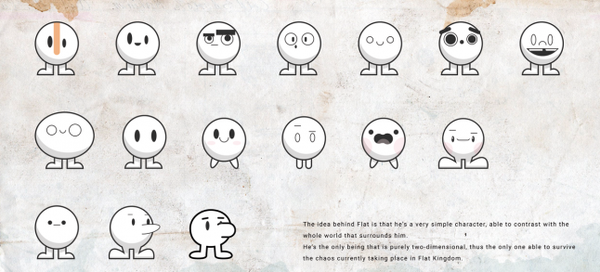
A circle must be seen as a circle, a triangle as a triangle, and a square as a square. This is due directly to the principle of function over form and should be a priority when making a decision to choose which design we wanted to develop.
Strengths.
Courage.
Flat is bold and adventurous, not afraid of challenges, and always willing to take risks for his cause. Despite the adversities that are presented, he always forges ahead. This is constantly demonstrated in the animations of his head, where he often seems surprised or scared, he perseveres and then decides that the situation is fight or die.
Loyalty.
Because he has grown up all his life in the castle with the royal family, his devotion and loyalty to them is very high. He follows all orders the king gives, and is very respectful to the citizens and soldiers of the kingdom. His friendship with the princess is very strong, as they have been companions throughout his entire life. Therefore, upon learning she’s in danger and has been kidnapped, he rushes off to her rescue.
Innocence.
Flat has something like the mind of a child. He does not judge and does not perceive evil in the world. Has a peaceful and friendly soul, except when his loved ones are in danger.
Unique.
Flat’s origin is actually unknown, but there is evidence that he could be the purest and most powerful creature in all of Flat Kingdom because of his ability to change shape. His very existence challenges the nature of the world in which they live, so the significance of Flat is very high. However, due to his humble nature, Flat does not seem to realize that he is special and lives among the other citizens without them feeling the need to revere or fear him.
Weaknesses.
Naive.
Due to his innocence, Flat trusts too much in people and blindly follows the orders given to him. Even when he feels cheated, he goes to help the princess without thinking twice.
Impulsive.
This quality can be counterproductive. Again, due to his enthusiasm to save the princess, he embarks on an adventure without understanding many things. The player’s role is to find and examine the nuances of morality within the stories of the game after reading about them, and to reach understanding passively over the course of the adventure. Flat feels no empathy for the enemies because he has a very clear mission and nothing will stop him until he achieves it.
Simple.
Flat has a one-track mind. The whole problem of jewels and chaos between dimensions, really doesn’t matter to him. He does not know or understand why Hex is stealing jewelry, why they are important, and why the animals of the kingdom attack him. He only knows that the princess was kidnapped and he must save her.
Taking these qualities into account, it is clear that Flat, rather than being a bold and heroic knight, is really more like a pet / companion, faithful and cute. The game constantly defines him not as an adventurer or warrior, but as a guardian. Therefore, the design should be kept simple, flat, and functional above all else.
Looking for funding and the impact of external critics.
October 2013

In it’s first version, the aesthetics of the game were entirely low poly, but we saw that the development of all assets using this technique would not be feasible due to time constraints and the complexity of the production. We instead chose to drop the low poly direction and develop an art style based on a much more interesting concept. For the final product, it would be best if we focused on a 2D world. Originally, all that was 2D in the game was the castle, and we ended up reversing the proportions by changing many low poly elements of the game to 2D.
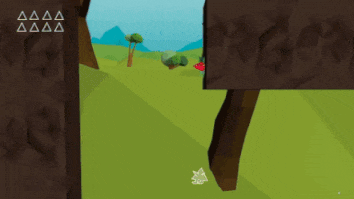
To understand the changes we made in the project, we have to explain how we interacted with players from the very beginning.
We took Flat Kingdom to anime conventions and held small events where we invited players to try the game. This helped us test the mechanical and dynamic aspects of the game. Sometimes players commented that the villain, Hex, outshined the protagonist, but since the project was already in progress, we decided to continue and ignore things that would have required additional time we did not feel that we had, due to lack of funds.

The results of the first stage of feedback / review led us to give the character more skills and to put more effort into increasing the number of phases in the game.
October 2014
We took a gamble and decided to try our luck using crowdfunding to finance the game. We decided on launching a campaign on IndieGoGo, initially we were really optimistic because we got support veteran video game composer Manami Matsumae (Megaman, Shovel Knight), who composed a song for the game. At that time, we had to learn many things and we made every rookie mistake that one possibly can, such as the failure to create a sufficient community or to make press contacts before launch. Even basic things, such as sending an email to the media without hiding all the recipients and several influencers began mocking these mistakes, so our effort to capture attention did not help us out much.
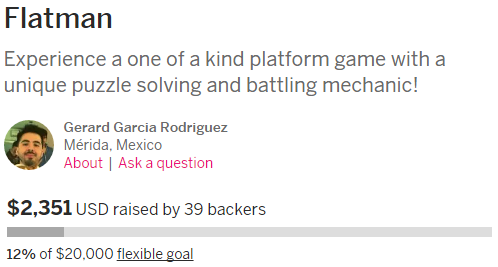
Once we put the demo online people began to support us, but it was almost at the end of the campaign and we only raised 12% of what we needed. To top it off, we had to change the name of the game. Initially the project was called FlatMan, but it didn’t take long for us to get contacted by Marvel, who warned us that we were using their brand FlatMan (from a superhero of theirs). And that’s how we found the definitive name for the game, Flat Kingdom.
November 2014
We attended events to pitch the game, and articles on the potential of the game were written at the same time, so decided to try our luck at launching a second crowdfunding campaign, this time on the more popular Kickstarter, where we had higher hopes we would obtain the funds needed to complete the project. We were more hopeful since we would apply what we learned from our previously failed IndieGoGo attempt. So the campaign inched forward until the time came when we were within sight of the goal, but approaching the end with only 85% raised, we were stricken with fear, so decided to fill that missing percentage with some of our own personal money. As the payment was made using the same credit card that we used to initially register, Kickstarter saw this and cancelled the entire campaign.

We admitted our error in front of the community via a formal statement because ethics dictates that we failed our backers. Because of our desperation, we were ready to do almost anything to make Flat Kingdom a reality.
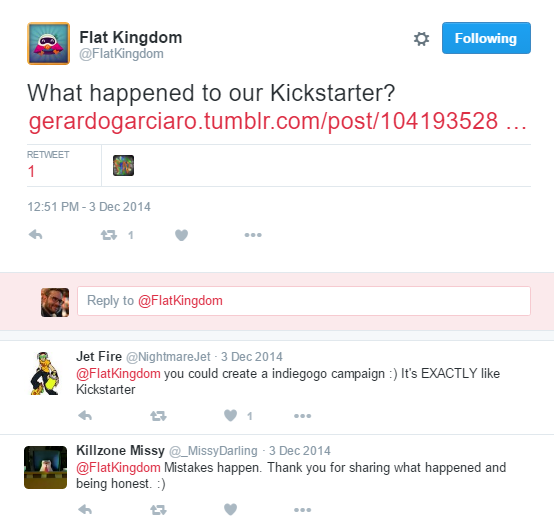
By this time, we had sacrificed safe jobs, time with friends, family and other loved ones and many other common sacrifices that most game developers expect to make during crunch time. We were giving our lives for the project.

With that same attitude of taking responsibility, we used both the blog and social media postings to alert all backers that their money had been returned, but when the game finally did come out, they would receive a free product key to download the game as recognition of the support they gave us. Even after they had their money returned, all backers were still to be given their copies when the game went on sale. 100% of the subsequent criticism of our critics came from Mexico. All this external lack of understanding for our moral stance affected us, but it did not change our position. It just meant we would have to go forward by ourselves, more self-committed, and not think so much about any negativity came from outside.
Apparently this error brought us not only negative things, it gave us some unexpected attention in the form of other people who wanted to help us to make the game a reality, as we will see in the next chapter.
Early 2015 - 2016: Incubation and publishing. The Games Starter Era.
We had not obtained any funds for the project through crowdfunding, but from the many pitches we did for the game, there was one company that was interested in working with us and supporting the development. It was a young startup named Games Starter, an incubator and publisher of indie games. They would finance all the remaining game development as our partners, also would hire Manami to work in the rest of the soundtrack and henceforth would take over all communications and marketing for any product with the brand Flat Kingdom, while allowing us to keep the intellectual property rights.

A new stage began, in which Games Starter helped and supervised the production of the game to be ready as soon as possible, while helping us to spread the word about it on social networks and schedule press and events. That was when the idea to rethink / improve the main character first emerged, though nothing convinced us to do so. Several proposals were made, but nobody was fully satisfied by any of them. Later we would see that this was due to flawed thinking and fondness for the character that had looked like this for almost two years.
January to March 2016 - Pre-release.
During the first few months of 2016, we attended PAX South, PAX East, and GDC, held public events and received very positive feedback. There were no relevant complaints about the character beyond some players who puzzled over the design, but did not know exactly how they would improve the character. As Henry Ford said, "If I had asked people what they wanted, they would have said faster horses." Personally, I believe we got to that point because we never let the people to take part in the creative process of the game by discussing it, and we kept thinking they were isolated comments that would not have a direct effect on the commercial success of the game.
April 2016 - Launch.
The launch was complicated, as we were confident that the game was polished enough from the positive feedback of many local testers and events in the previous months, nevertheless during those previous month to launch we decided to invest on improving all the sound design, since it wasn’t on par with Manami’s work. For that we hired the Brazilian studio Yoho Musik Arsenal, who produced a lot of great material and set a true direction for the game atmosphere, effects etc. However there was an issue we didn’t expect, some new sound effects were added two weeks before launch that caused major problems. We were very worried since these sound effects affected the operation of the game to the point of creating serious bugs, but again we faced stormy weather as multiple errors kept coming up. They were quickly corrected, but this left us in an uncertain state about how the game would run. The release date was looming, merely a few days away, and all we could do is test and test some more. The idea of launching the game in Early Access was suggested, but the bad reputation of this model overall didn’t convince anyone that this was the best choice. So we instead opted for a quiet launch, spreading the game to the media only when we knew that there was nothing seriously wrong.

Our assumption could not have been further from reality, and after launching the game prematurely to sales that were well below those expected, alarms were going off. That was when we started seriously looking into the reasons the market was not responding to the game as we expected, and identified changing the main character appearance as one of the main actions to be taken. The game design itself would also be something to improve but was not viable with the time and resources left to this project.
April to June 2016 - Redesigning Flat.
There were several improvements we knew we would need to implement since launch, but the clearest goal was a redesign of the main character. We started by planning to spend a week redesigning, but that ended up taking two weeks, so we reduced the animation time to a week and a half. We knew it would take a total crunch time of about a month, so started brainstorming and sketching from many scattered influences. This process went several steps between us, the developers, and the publisher.

Talks and discussions took place, laughs and tears were had. It was a very intense time because of what it meant to each of the us to relaunch the game properly, and because of that we wanted it to do so well. Both sides cared about giving the character whatever it was that it was missing. Flat was originally a simple outline that looked like many other games, now he needed to make sense with the narrative and design of the universe, as well as visually indicating that this was a game that is challenging and not easy. This was another problem with the previous design. So we started to throw and discuss new design ideas for the new Flat on the table.


Variations in solid colors of the character’s evolution, visual hints of Super Meat Boy.
 Exploring shape with color and texture. Here we tried glowing and PlayStation color palettes.
Exploring shape with color and texture. Here we tried glowing and PlayStation color palettes.

Trying character approaches rather than geometric figures. Based in Akira Toriyama’s Dragon Quest designs. Simple characters with large, expressive eyes, with basic medieval clothes that would not distract from the overall shape.

Flat was created as an experiment to challenge forms and nature. They wanted to create a guardian who could protect the kingdom in case of an emergency.

Flat was created to be the defender of the kingdom, able to affect his world not unlike Neo in The Matrix.

We believed the idea of this bright eyed character was very interesting. Given a magical cape and a belt with the royal emblem, since it was found by the king and ordained as a guardian. The fire element would be used as a distinctive indicator of player status, besides just the form of the character, as a reinforcer in the form of color.

Exploring the same look, but with a black color scheme, almost a kind of devil. The only problem with this is that the character seems like a villain, and looks more dark and mysterious than you would want.

More proposals made by mixing up forms and expressions. I personally think some of these make the mystery even deeper.
Below you can find a set of characters with symbols on their faces, or fire which would grow depending on the amount of skills you had obtained. When you get the Flat Perfect form and have all abilities, the color of the fire on his head would change. The main inspiration was the fairy, Navi, from The Legend of Zelda: Ocarina of Time, as the familiar to Link, also a silent hero.

As you have seen in the pictures above, we had many proposals to choose from, until finally we fashioned the brave little warrior that can be seen in the picture below. It is mysterious sorcerer, a much more expressive and colorful character, whose transformations are meant to be a visual delight.

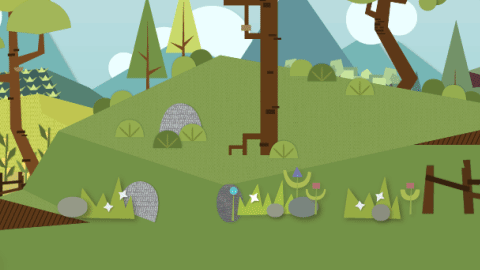
Above: Final Design and some animations.
We did not want to have shields or items that he would not use in the end. We also decided to add a final mysterious boss which would not speak, but who was intrinsically related to the origin of Flat. Only if you get 100% in the game can you fight and know the whole story.
Now the marathon began to replace sprites, achievements, advertising, and in-game cinematics. The hardest problem was already solved, but not without the arduous process of proposals, meetings and changes.

Simultaneously, as this was a move that (at least for us) had not been seen before, Games Starter prepared a media plan to prepare people for the update, so there would be no confusion about the changes and highlight the improvements made to the game with the addition of multiple languages and other added extras. We saw it as a kind of rebranding of the game and affectionately call it Paper’s Cut instead of Director's Cut. Comments before implementing the changes could not have been more favorable.

Conclusion:
After renaming our game, two failed crowdfunding campaigns and local criticism, we went to the extreme and lacked balance. When adapting between the feedback from players and our vision as creators, it is often difficult to hear everything people were saying and modify our game without losing its identity / essence.
Flat Kingdom has been an opportunity for very intimate and personal expression for everyone involved in its development, and one of the biggest lessons we’ve learned for the future is not to underestimate the importance of any feedback given to a project. Don’t obsess over it, but rather critically analyze all comments and do not try to convince the world that they must love your work, while not understanding it. The first results could have been better if we had embraced feedback from more people and asked more specifically about issues like the main character design. Regardless, people are reacting very positively to the new design and improvements we’ve implemented into the game. We are still far from recovering the investments made, but we are optimistic seeing the positive response Flat Kingdom has been receiving from the gaming community to the improvements made in the three months following the launch and during the summer sales on Steam and other platforms:
.png/?width=600&auto=webp&quality=80&disable=upscale)
Seeing the response in sales, we wonder if it would be interesting in the future to include the original Flat design as another selectable character, or perhaps even the villain, Hex...
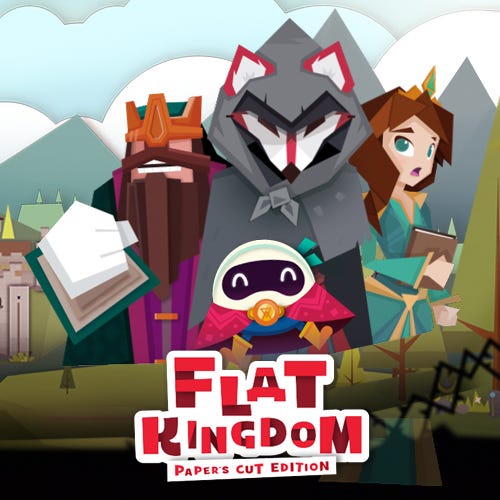
With Flat Kingdom, we learned that making games is a team effort in which the participation of players and other industry professionals is necessary to shape the passion and hard work we deliver during the creative process.
We artists are very often blinded by our work and, after being faithful to what we assume it means to carry the indie games flag, sometimes put an unnecessary barrier between us and our audience when we should do just the opposite and welcome their participation, in addition to learning from the mistakes we make along the way. This process is difficult, and in these times where independent developers can fulfill the dream of making games easier than ever, it can be very confusing for those who have just started to know which are the best first steps to take. Many people are very jealous about sharing any valuable information, however there were people with experience that inspired us to kickstart our company by giving us great knowledge without asking anything in return. This makes us want to give back a little to the people who are venturing into this madness, among other things, by writing stories like ours in this article. We hope that this text will encourage them to share all those personal gamedev stories that have not been written yet, or even are being created at this exact moment.
We began our journey with Flat Kingdom in Mexico, a moving adventure that took the whole team north of the country to meet special people, see amazing places, and gain new knowledge and experiences. We can’t know what the commercial future of Flat Kingdom will be, but I'm very happy with what the current version gives to the players. It is a unique platformer, challenging, beautiful both visually and aurally, where every corner has little details to observe and tributes to the games that inspired us to make this modern retro experience. All of this is thanks to a small group of very talented people who supported the project from the beginning, a group which more professionals from different backgrounds and nationalities later joined. I feel truly honored to have had their support in the development of this game.

I will end with a phrase that concludes my favorite animated film : Ratatouille, a statement on criticism by Anton Ego. "The world is often unkind to new talent...new creations. The new needs friends." I hope you have enjoyed reading our history.
Authors: Gerardo Garcia (Fat Panda), with the collaboration of Jesús Fabre (Games Starter) and translated by Ryan “Artie” Tompkins (Games Starter).
Flat Kingdom has been developed in Mexico by Fat Panda Games and published by Games Starter. If you are interested in knowing more about it, check out the following links:
Official website: http://flatkingdom.com/
Facebook: https://www.facebook.com/flatkingdom
Twitter: https://twitter.com/FlatKingdom
Humble Store: https://www.humblebundle.com/store/flat-kingdom
Read more about:
Featured BlogsAbout the Author(s)
You May Also Like


